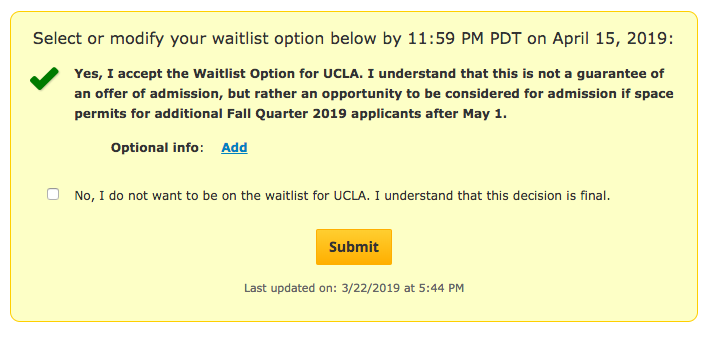We seniors have waited for months in anticipation of April 1. Before that, we were writing about our life stories and passions. Even before that, we were working as hard as we possibly could to set ourselves up for the best college outcomes. We worked for months, even years. In a way, we were waiting during all that time too.
Yet, for many of us, March came to a close without the endgame we were expecting. The long-awaited end of the college process left less closure than ever before. Rejections were sent, opened, and felt. But, possibly even worse, the waitlists had been filled with hundreds of students across the United States. More waiting.
No, this waitlist game is not new. But it is a growing issue.
The Wall Street Journal article “Did Your Kid Get Placed On a College Wait List? Don’t Hold Your Breath” was published in April 2017. It refers to the general waitlist as: “a rapidly growing admissions limbo from which few students escape.”
It reflects the true nature of a waitlist: it is not so much a list but it is a pool that hundreds if not thousands of qualified students swim around in for months on end. The suspense only extends the college process by keeping students hanging on even after being put on the B-list by an institution.
Granted, the waitlist is not a rejection.
“This year, we received over [large #] applications for an entering class of only [small #] students. Given the relatively small size of the incoming class and the strength of our applicant pool, we cannot admit all of the qualified applicants who apply to [university or college]. As such, you should not feel our decision reflects negatively on you or your potential as a college student,” is the generic statement released by hundreds of universities this year.
It hurts. But at least this is a true verdict. One never has to get tentatively excited for one school while secretly hoping for another one to come back and want them.
In fall 2018, the University of Michigan admitted 7 percent, or 434 of that year’s 6,183 waitlisted students. Over 6,000 students waited anxiously to see if they got in and only about 1 in every 12 of them got sent that “Congratulations!” email.
If that seems like an uncomfortably low number, in fall of 2016 UMich admitted just 1 percent of their waitlisted students. Only 36 kids got offered admission off the waitlist of thousands.
It should be noted that UMich hit a record high for the number of applicants in 2017. UCLA and Northwestern reported their own record highs in 2018. It makes sense that their waitlists would grow as the number of students who apply grows. For perspective, Harvard’s class of 1969 had a little under 7,000 applicants compared to almost 43,000 applicants for the class of 2022.
However, only adding to that problem, the number of schools that students apply to has increased. Although Prep Scholar acknowledges that the number of colleges students should apply to varies based on what is right for the individual, it generally hovers at about 15 in recent years. My parents each applied to six, and my grandparents put together applied to three colleges in total.
Optimistically, applying to more schools means more chances for acceptance, but, realistically, it means just as many chances for rejection. The joy of waitlisting is that it isn’t either; it is unease caught in the middle of a cracking system that is scrambling to keep everything in order.
The combination of increasing the number of applicants and increasing the total number of schools that students are applying to, alongside the pressure on universities to maintain their low acceptance rates for prestige, means lots of disappointment. It also means a lot more waiting, as an increasing number of kids hold onto hopes for different futures as they are pushed to commit to other ones. In some cases, that hope is based on a 1 percent chance. That means, for many the waitlist is false hope.
The facts don’t make the process easier on anyone.
For one, we cannot pretend the system is ok right now. To reiterate: the numbers are just going up (how many applicants, schools being applied to, financial aid requests, tuition prices). There has to be a breaking point in the near future. The college admissions fraud investigations might just be the start of a larger problem with the process as a whole.
For another, we as students cannot expect this fractured system to work for us. The waitlist is not a guarantee, now more than ever. Being put on one is nothing to sneeze at or ignore. It is an achievement. But it is something to be wary of. The hope should be kept in check and we should be excited for wherever is excited to welcome us.
*This editorial reflects the views of the Scot Scoop editorial board. This editorial was written by Talia Fine.


